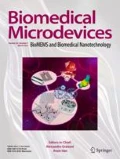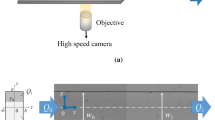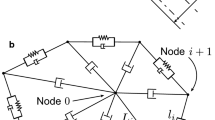Abstract
The retinal arterial network is the only source of the highly nutrient-consumptive retina, thus any insult on the arteries can impair the retinal oxygen and nutrient supply and affect its normal function. The aim of this work is to study the influences of vascular structure variation on the flow and pressure characteristics via microfluidic devices. Two sets of micro-channel were designed to mimic the stenosed microvessels and dichotomous branching structure in the retinal arteries. Three working fluids including red blood cell (RBC) suspension were employed to investigate the pressure drop in the stenosed channel. The flow behaviors of RBC suspensions inside the micro channels were observed using high speed camera system. Pressure drop of different working fluids and RBC velocity profiles in the stenosed channel were obtained. Moreover, hematocrit levels of RBC suspensions inside the bifurcated channels were analyzed from the sequential images of RBC flow. The results of the flow in the stenosed channel show that RBCs drift from the center of the channels, and RBC velocity is influenced not only by the inlet flow rate but also the interaction between RBCs. The measured pressure drops in the stenosed channel increase notably with the increase of fluid viscosity. Furthermore, the dimensionless pressure drop due to the stenosis decreases with Reynolds number. On the other hand, the results of flow through the bifurcated channels show that as the ratio of the daughter-branch width to the mother-channel width increases, the ratio of hematocrit in two connected branches (Ht/Hd) decreases, which is in favorable agreement with the available analysis results.












Similar content being viewed by others
References
W.-Y. Au, E.S.K. Ma, P.C. Chow, Y.-T. Kan, Sudden blindness due to bilateral central retinal artery occlusion in a patient on eltrombopag. Ann. Hematol. 93(5), 881–882 (2014)
M. Bahrami, M.M. Yovanovich, J.R. Culham, Pressure drop of fully-developed, laminar flow in microchannels of arbitrary cross-section. J. Fluids Eng. 128(5), 1036–1044 (2006)
H.J. Byung, M. Linda, L. Van et al., Three-dimensional micro-channel fabrication in polydimethylsiloxane (PDMS) elastomer. J. Microelectromech. Syst. 9(1), 76–81 (2000)
K.-D. Choi, J.-U. Chun, M.G. Han, S.-H. Park, J.S. Kim, Embolic internal auditory artery infarction from vertebral artery dissection. J. Neurol. Sci. 246(1–2), 169–172 (2006)
A. Dhawdal, B. Wiggs, C.M. Doerschuk, R.D. Kamm, Effects of anatomic variability on blood flow and pressure gradients in the pulmonary capillaries. J. Appl. Physiol. 83, 1711–1720 (1997)
L. Fen, R. Hu, T. Yamada et al., The observations of the flow behavior and distribution of red blood cells flowing through a micro-network channel. Chin. J. Theor. Appl. Mech. 46(1), 1–9 (2014)
H. Fujiwara, T. Ishikawa et al., Red blood cell motions in high-hematocrit blood flowing through a stenosed microchannel. J. Biomech. 42, 838–843 (2009)
Y.Q. Huang, C.M. Doerschuk, R.D. Kamm, Computational modeling of RBC and neutrophil transit through the pulmonary capillaries. J. Appl. Physiol. 90, 545–564 (2001)
T. Hyakutake, S. Nagai, Numerical simulation of red blood cell distributions in three-dimensional microvascular bifurcations. Microvasc. Res. 97, 115–123 (2015)
O. Ismi, Y. Vayisoglu, E. Dinc, O. Yildirim, M. Unal, Central retinal artery occlusion and irreversible blindness due to paranasal sinus infection in a pregnant woman. J. Craniofac. Surg. (2014).
J.C. Ji, Hemodynamic analysis of the pathogenesis of renal vascular hypertension. PHD thesis, University of Science and Technology of China, (2014).
G. Le, J. Zhang, A non-iterative mathematical description of three-dimensional bifurcation geometry for biofluid simulations. Appl. Math. Modell. 1–13 (2014).
V. Leble, R. Lima, R. Dias, C. Fernandes, T. Ishikawa, Y. Imai, T. Yamaguchi, Asymmetry of red blood cell motions in a microchannel with a diverging and converging bifurcation. Biomicrofluidics 5(4), 44120–4412015 (2011)
D. Liu, N.B. Wood, N. Witt et al., Assessment of energy requirement for the retinal arterial network in normal and hypertensive subjects. J. Biomech. Eng. 134(1), 014501 (2012)
MicroChem, Permanent epoxy negative photoresist processing guidelines for: SU-8 2025, SU-8 2035, SU-8 2050 and SU-8 2075.
S. Oba, S. Tanaka, S. Oka, H. Kanao, S. Yoshida, F. Shimamoto, K. Chayama, Characterization of colorectal tumors using narrow-band imaging magnification: combined diagnosis with both pit pattern and microvessel features. Scand. J. Gastroenterol. 45(9), 1084–1092 (2010)
B.D. Obrist et al., Red blood cell distribution in simplified capillary networks. Phil. Trans. R. Soc. A 368, 2897–2918 (2010)
C. Pozrikidis, Axisymmetric motion of a file of red blood cells through capillaries. Phys. Fluids 17, 031503 (2005). 1—14
Z. Shen, Y.A. He, L. Boltzmann, Method for simulating the separation of red blood cells at microvascular bifurcations. Chin. Phys. Lett. 29, 024703 (2012)
Y. Song, P. Manneville, C.N. Baroud, Local interactions and the global organization of a two-phase flow in a branching tree. Phys. Rev. Lett. 105(13), 134501 (2010)
Y. Song, M. Baudoin, P. Manneville, C.N. Baroud, The air-liquid flow in a microfluidic airway tree. Med. Eng. Phys. 33(7), 849–856 (2011)
Y. Wada, S. Kudo, H. Kashida, N. Ikehara, H. Inoue, F. Yamamura, K. Ohtsuka, S. Hamatani, Diagnosis of colorectal lesions with the magnifying narrow-band imaging system. Gastrointest. Endosc. 70(3), 522–531 (2009)
G.J. Wang, K.H. Ho, S.H. Hsu et al., Microvessel scaffold with circular microchannels by photoresist melting. Biomed. Microdevices 9, 657–663 (2007)
W. Xiong, J. Zhang, Two-dimensional lattice Boltzmann study of red blood cell motion through microvascular bifurcation: cell deformability and suspending viscosity effects. Biomech. Model. Mechanobiol. 11(3–4), 575–583 (2012)
J. Zhou, A. Vera Ellis, N.H. Voelcker, Recent developments in PDMS surface modification for microfluidic devices. Electrophoresis 31, 2–16 (2010)
Acknowledgments
The work was partially supported by The Fundamental Research Funds for the Central Universities of Dalian University of Technology (No. 2342013DUT13RC(3)104)
Author information
Authors and Affiliations
Corresponding authors
Rights and permissions
About this article
Cite this article
Hu, R., Li, F., Lv, J. et al. Microfluidic analysis of pressure drop and flow behavior in hypertensive micro vessels. Biomed Microdevices 17, 60 (2015). https://doi.org/10.1007/s10544-015-9959-4
Published:
DOI: https://doi.org/10.1007/s10544-015-9959-4




